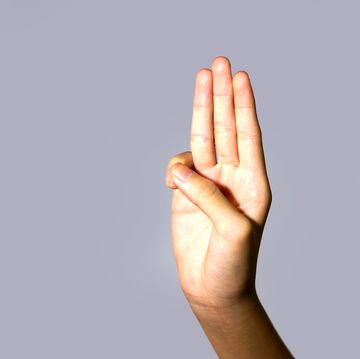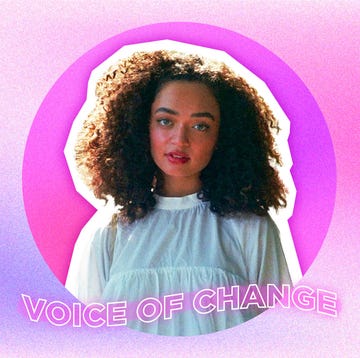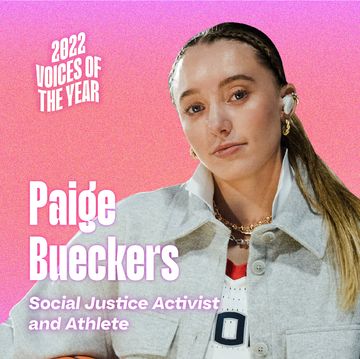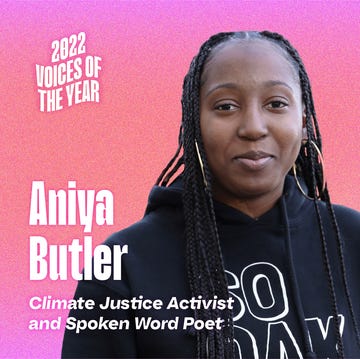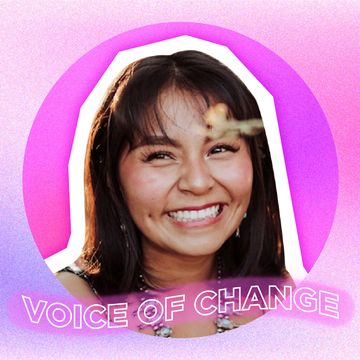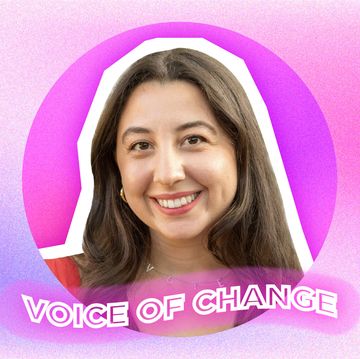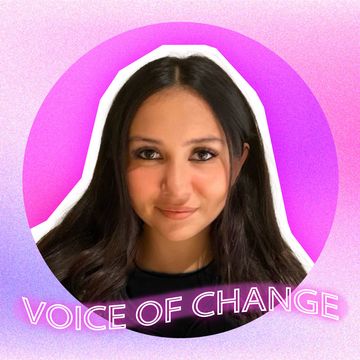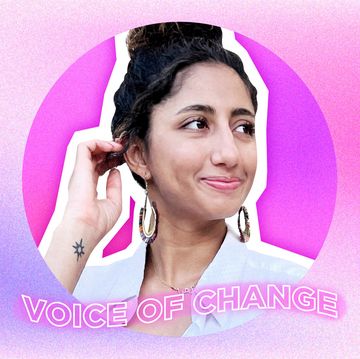Generation X is all about saving the world. What young people everywhere share is a common hope for the future, outrage with injustice, and dedication to progress. And we’ve learned one thing’s for certain: We’re stronger together. So, that raises the question: In a generation of advocates, what ties us all together?
The answer is simple: the planet we all live on.
The climate emergency is the only thing that affects us all. If you’re anything like me, climate change has been on your radar for as long as you can remember, but always seemed too scary and too distant to solve.
More From Seventeen

Until now.
On March 15 and May 24 of 2019, I joined millions of students across the globe in a “school strike” to save our planet. We rallied outside local government buildings and institutions like the Museum of Natural History in New York City, demanding action to help save the environment.
The global school strikes were far from my first protest, and definitely not my last (since then, I've rallied with Greta Thunberg at the UN climate change strike in August). I’d also organized walkouts and rallies for gun reform after Parkland. But standing on the steps of the Natural History Museum among thousands of my peers, I knew right away that this movement is bigger, deeper, and more powerful than anything I’d ever experienced. The sense of community was overwhelming as we sung out chants, angry but hopeful, carrying signs with messages of resistance, all intensely aware of the fact that our peers around the world were, at that very moment, doing exactly the same. And the craziest part is, it all started with one teenage girl.
Greta Thunberg is a 16 year-old Swedish activist who created School Strike For Climate. It all started in August of 2018, when Greta began protesting outside the Swedish parliament to demand immediate action to stop climate change, during school hours. Soon, other students joined her, from long-time climate activists to students like me, who have been waiting for an opportunity to get involved.
Today, I’m part of an organization called US Youth Climate Strike and New York City’s chapter of Fridays For Future, two of the major organizations behind these school strikes to protest climate change. I’ve worked with both to organize rallies, marches, and sit-ins, and I’m currently working on my city’s US Youth Climate Strike boot camp. September 20th marks the next big climate change strike, and I can't wait to represent NYC on the big day.
I’ve gotten to know some seriously brilliant activists through my work in the movement, and I’m constantly blown away by their ideas and fierce dedication to change through words and action.
But change begins when we all make the effort to amplify each other’s voices, and make each other’s plans and ideas known. So I talked to some teens about their work in the climate movement, how they became climate activists, the power of student protests, and where they see #SCHOOLSTRIKE4CLIMATE going next...
“I joined the climate movement because, frankly, I was terrified of what my future would entail, or if I would ever get one at all. The first major thing I did for the climate movement was organizing a climate summit with my friends. From there, we expanded the summits and officially launched the organization, Youth Climate Summit USA. Its main focus is to organize local summits for young people to learn about climate change and how to combat it. I have always been adamant that youth-led organization should be youth-led, and I really wanted my organization to be led by high school students. So the moment that I officially graduated from high school, I moved away from being a climate summit organizer to a climate summit advisor. Currently, I have been spending my time working with a variety of other, more local, organizations to help my community.” —Absa Fall, 17, advisor and co-founder of Youth Climate Summit USA
“In the 6th grade, I read An Inconvenient Truth by Al Gore. I was so confused, at that age, how a problem like climate change could be so large and yet it seemed like nothing was being done to address the issue. I thought that the only way this could be happening was because no one knew about it, and so for much of middle school I dedicated myself to educating people about climate change.
After that, I moved away from climate change for a few years. Now that young people have taken on climate change as the defining issue of our generation, I’ve jumped right back in and can feel that this time is different — this is the revolution that’s going to save our planet. Climate change is the largest threat to our generation. If action is not taken now, the earth as we know it will not be around for much longer. As young people, we will be forced to deal with the worst effects of the climate crisis in the years and decades to come. Adults have failed us, and if we, as a generation, don’t step up to demand change, we’ll be failing all the kids to come after us.
We may not have caused this problem, but it is our responsibility to do something to fix it. Future Coalition is the largest network of youth-led organizations and youth organizers across the country. This is our time, as a generation, to band together and demand change.” —Katie Eder, 19, executive director of Future Coalition
“It was while watching Greta Thunberg’s COP24 speech that I became infuriated by the lack of climate action in the United States. In her speech, Greta said, 'We have come here to let you know that change is coming, whether you like it or not. The real power belongs to the people.' I tried to channel that energy into action when I decided that I would organize a climate strike at my high school, Bronx Science in NYC. I had never really considered myself an activist, but Greta’s leadership and urgency pushed me to turn all the talking I could do about the climate movement into action.
Right now, I am working on getting House Resolution 763 passed in the upcoming session of Congress by working closely with the Citizen's Climate Lobby and the Four Freedoms Democratic Club. We are just in the planning phase right now, but the bill is a carbon dividend bill that hopes to drive down America's carbon pollution and bring climate change under control." —Azalea Danes, 16, Bronx Science Climate Strike, Fridays For Future NYC
“I joined the climate movement because I want to bring awareness about the disproportionate effects of climate change in communities of color. People are also fleeing from their homes in response to the effects of climate change in which they do not have a place to call home, or have to leave everything behind.
It started when I was in middle school, painting an art piece for the Las Vegas Earth Day contest. I painted a scene that depicted a solar panel community and a clean water generator and the painted wound up being displayed at a local gallery. That's when I realized that art was a start to my advocacy for the environment. I later realized art was not the only way to raise awareness. I got involved with local advocacy groups and later, the US Youth Climate Strike. Along with getting involved with the US Youth Climate strike, I use my platform as a former Nevada Youth Legislator to talk to different Nevada politicians about the effects of climate change in our Las Vegas community and ways they can bring up the issue during the legislative session.” —Salomée Levy, 17, State Liaison for US Youth Climate Strike
“I’ve always cared a lot about the environment, but environmental issues were mainly at the back of my mind until this year. I took AP Environmental Science this year and it brought environmental issues to the forefront of my mind. As a student, I felt really helpless and I knew that I had to join the Fridays for the Future marches because as much as not using plastic straws and thrifting clothes is good on an individual level, the only way dramatic change can happen is through policy.
In college, I want to major in Environmental Studies because I need to do everything I possibly can to save the earth. Politicians and massive corporations have put our futures at risk for the sake of their financial gain for too long. As much as I would like to believe everyone in the world can band together and save the environment, though we can try our best to do so, right now it’s up to those in power. And since the majority of those in power don’t seem to be doing anything, as students, it’s up to us to fight them with science and mass movements." —Lena Farley, 16, activist
“In my junior year, I learned about Greta Thunberg and realized there was a NYC branch of her movement headed by Alexandria Villaseñor. I wanted to do something, so I decided to organize my school to walk out on March 15th and join the citywide rally. Almost 1,000 students walked out of my school that day. I was so inspired by the energy and passion that NYC youth exhibited that day. I realized I wanted to keep organizing and striking, and I soon became one of the leaders of Fridays for Future NYC.
The youth climate movement is going to continue striking and continue building. We will be a constant increasingly strong presence until we are satisfied with legislative action to address the climate crisis on a global scale.” —Olivia “Olive” Wohlgemuth, Fridays For Future NYC
“I used to live in northern California, and I ended up visiting family back in California in November when the Paradise, CA fire broke out. My hometown of Davis was only an hour away from Paradise so we got a lot of the smoke. It was the worst air quality in the world at one point. To protect my health (because I have asthma), my family sent me back to New York City early. At this point, I was really upset. I ended up making the connection that climate change is fueling California's wildfires and making them more intense. I started researching about the climate crisis and paying attention to COP24. I had seen Greta Thunberg speak at COP24 and I saw her call to action. She had empowered me to end up taking my first form of advocacy on December 14th of 2018 (the last day of COP24). On that day I decided to go to a school strike for climate in front of the United Nations Headquarters, demanding action from world leaders.
During the first couple weeks of my climate strike, a mother came to my strike and started crying. She said she was worried about her daughter’s future. This was a meaningful experience because of how the climate movement is bringing people together and building a safe community where we can talk truthfully. It is taking the worry and the pain and using it to fight for our future.”—Alexandria Villaseñor, 14, Earth Uprising, Fridays For Future NYC
Grace Goldstein is a 17-year-old writer, composer and activist from New York City. She’s a senior at Stuyvesant High School where she’s organized school walkouts for climate action and gun reform. She’s NY State Director of US Youth Climate Strike, a member of Fridays For Future, and part of the core organizing committee for the September 20th Global Climate Strike with Greta Thunberg in NYC.








